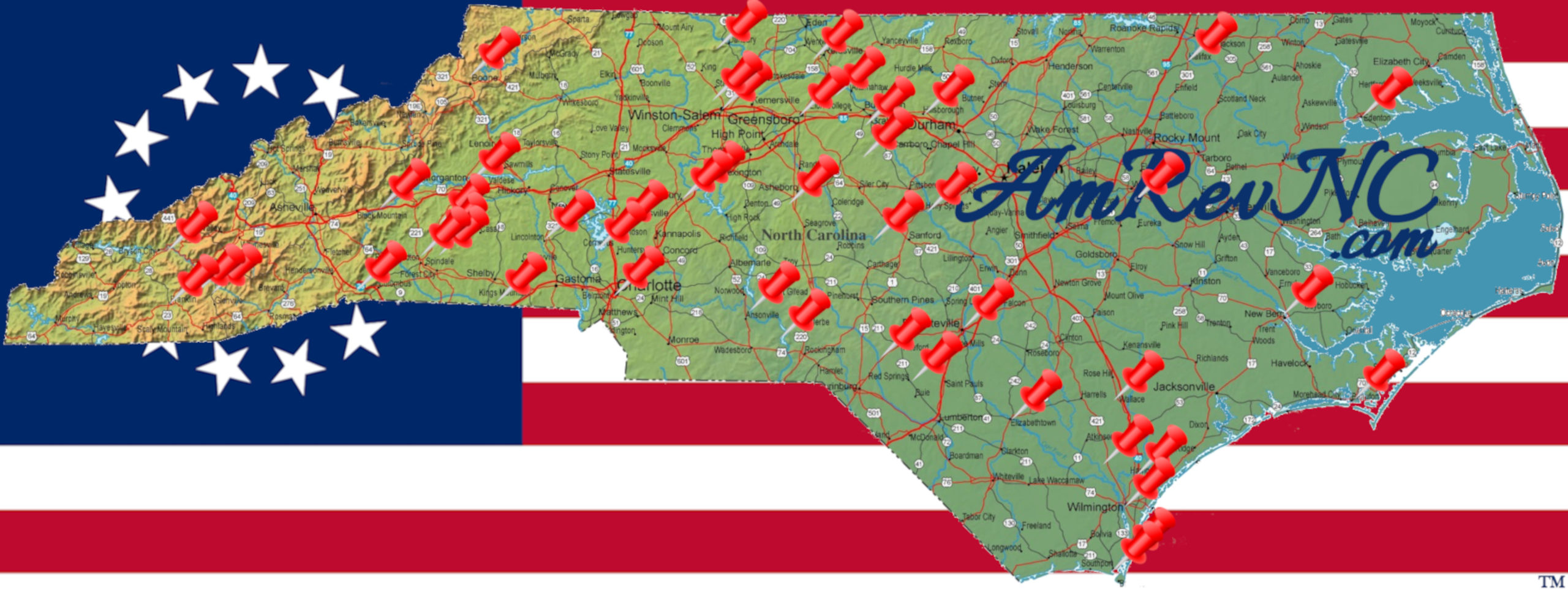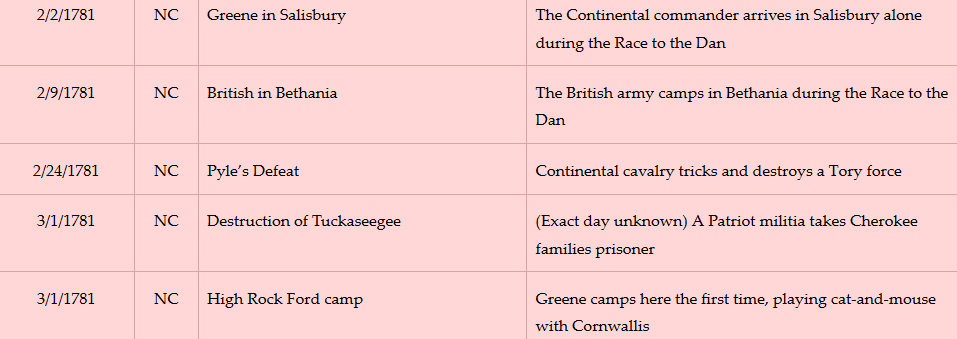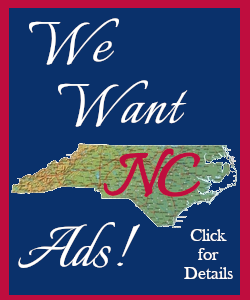A Deception Turns Deadly
Location
Other maps: Bing, Google, MapQuest.
Coordinates: 36.0573, -79.4289.
Type: Sight
Tour: Regulators
County: Alamance
![]() Full
Full
Public right-of-way extends to the gravel off the end of Henry Road. Please respect property owners’ rights by going no further. At that point you are probably right where fighting occurred anyway.
The exact location of Pyle’s Defeat has been debated for many decades. An exhaustive review of land records and participant accounts was published in 2011.[1] It could not say for sure, but was convincing enough that the state changed the historical marker on Highway 49, a rare event.[2] This page aligns with that source’s conclusions.
Context
 After a chase from the Charlotte area to Virginia in early 1781, the two regular armies in the South are gathering supplies and volunteers: the Continentals near today’s South Boston, Va., and the British in Hillsborough.
After a chase from the Charlotte area to Virginia in early 1781, the two regular armies in the South are gathering supplies and volunteers: the Continentals near today’s South Boston, Va., and the British in Hillsborough.
Situation
British/Tory
Lt. Gen. Lord Charles Cornwallis has called for Loyalists (“Tories”) to join him, so around 300-400 men under Col. John Pyle, a doctor, are riding on horseback to Hillsborough. Cornwallis sent British cavalry commander Lt. Col. Banastre Tarleton to the area with 450 men to protect incoming volunteers. Tarleton camped in modern-day Burlington for that purpose, but some sources indicate he was as close as two miles west of this location.
Continental/Patriot
Maj. Gen. Nathanael Greene has sent Continental regular cavalry and Patriot militia totaling about 600, under Lt. Col. Henry Lee, to intercept any Tories and try to engage Tarleton. Lee followed Tarleton’s trail of destruction from today’s Mebane. He crossed the Haw River at Swepsonville Ford to the east around 4 p.m., a few hours behind Tarleton. Thinking Tarleton might be at the farm of a suspected Tory, Michael Holt, Jr., he deployed to attack him there, to no avail.
Date
Saturday, February 24, 1781.
Timeline
Imagine the Scene
Horsemen Meet on a Road
 Walk to the end of Henry Road and look toward the cleared utility easement. In 1781 you would be standing on the Hillsborough-Salisbury Road, a dirt wagon road. Its sunken remains run to the left of that easement in the woods, and lead right to where you are standing.
Walk to the end of Henry Road and look toward the cleared utility easement. In 1781 you would be standing on the Hillsborough-Salisbury Road, a dirt wagon road. Its sunken remains run to the left of that easement in the woods, and lead right to where you are standing.
Pyle’s men are riding downhill past you in the direction you are facing, in two lines. They are part-time soldiers called “militia” in regular clothes of the day, most carrying muskets and maybe knives as their only weapons. They have green twigs or red swatches in their hatbands to identify them as Tories (Patriots wore white paper or fabric). It is nearly dusk, however, so those are hard to see at a distance.
Suddenly the men stop. There is a delay, and likely some grumbling about it, as you all wait to see what is happening. Finally orders are passed down the line: The men turn their horses around and squeeze the two lines to your left. Pyle himself rides up the hill toward you, headed to the new front of the line. Perhaps one of the men near you asks him what is going on, and you hear him answer that Tarleton is coming the other way and will escort them to his camp. More waiting ensues.

Soon, though, hoofbeats announce the approach of a single line of 75 green-uniformed cavalrymen led by their commander. Unlike the militia, who use their horses only for transport, these men are trained to fight from horseback and equipped with sabres and shorter guns including pistols.
Turn around. The road veered off to the right across today’s Cedar Crest Drive, through the side yard of the modern house.
Probably within your view down the slope, the commander pulls up by Pyle (to your right), salutes, and extends a hand to shake. Just then, however, the sounds of fighting emerge from behind you at the far end of the line.
Turn back around.
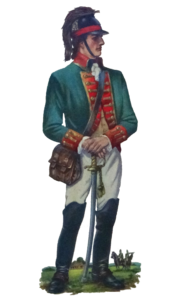
Like dominos falling, the “British” cavalry are drawing their swords and attacking the militia. Only they aren’t British, and that commander wasn’t Tarleton! Cavalry units on both sides of the war wear green coats; these are Continentals, and that was Lee you saw ride past.
At these close quarters, there is little the Tories can do to defend themselves. You hear various protests yelled: “‘You are killing your own men.’ ‘I am a friend to his Majesty.’ ‘Hurrah for King George!’”[3] Many around you fall hard to the ground bleeding, some already dead, as their horses run off in a panic.
One group manages to fire off a round in defense, but the only casualty is a Patriot horse. That group is quickly overwhelmed, and two Patriots roll the horse off their comrade. Injured in the fall, he is the only known casualty on the Continental side.
The other Tories not immediately felled scatter in all directions, some riding or running to your right through the Patriot line. The cavalrymen take off after the survivors, and you are left alone among the moans of the wounded.

You may want to read the “Historical Tidbit” below before going to the next stop.
In colder months when leaves are down, you may be able to see a remnant of the Hillsborough-Salisbury Road. Drive on Henry Road away from the dead end to the bottom of the slope. Pull off to the right and look into the woods along the streambed. What looks like a ravine running down the hill from where you were, and up the other side, is the worn-down remains. Turn around, or right at Lawndale Drive and right again at Lewis Drive, to get back to Cedar Crest.
Lee Approaches
On Cedar Crest:
- Drive north (left if facing the end of Henry) to Hanford Road.
- Turn right and drive to the next intersection, Hanford Hills Road.
- Turn right and park just past the first house on the right.
 You are on Michael Holt’s Farm. The Hillsborough-Salisbury Road continued from where you were in a straight line to about this point, continuing diagonally across the modern street toward and past Hanford Hills Road. (Notice the utility markers behind you across the street, marking the utility line you saw at the first stop that parallels the old road.)
You are on Michael Holt’s Farm. The Hillsborough-Salisbury Road continued from where you were in a straight line to about this point, continuing diagonally across the modern street toward and past Hanford Hills Road. (Notice the utility markers behind you across the street, marking the utility line you saw at the first stop that parallels the old road.)
Before the battle, the Patriots captured two of Pyle’s scouts somewhere on Holt’s large plantation. The scouts, too, mistook Lee for Tarleton due to the coats. Lee played along, and convinced them to go back to Pyle and ask him to step aside so his force could pass. He then deployed militia, some of them on foot, under Capt. Joseph Eggleston, to the right of the road shielded by the trees along it—or, they were still deployed for the earlier expected attack on Tarleton. Lee has them continue forward behind his unit.
Lee claimed later in his memoirs that he intended to bypass Pyle and continue after Tarleton. What happens next suggests he meant all along to attack, and these men were expected to help surround the Loyalists.
First, Lee’s men you saw earlier ride down the wagon road into the woods on your right. After a gap, Eggleston rides past you on the road with Capt. Joseph Graham, who is leading his own Patriot militia cavalry. Somewhere down the road ahead of you, they get near the back of the Tory column. Graham thinks these are Eggleston’s men already arrived. But those men have been slowed by the Holt Farm fences and the small stream ahead of you (lined by the trees you see running behind the modern house). Then Graham gets close enough to spot the red strips of cloth on their hats. He wonders aloud to Eggleston why the enemy still has their weapons if the Patriot militia had already captured them. Eggleston asks the last man in line, “Who do you belong to?”
“To King George,” is the answer.[4] Eggleston strikes him in the head with his sword. Some of the militia in the woods are close enough to see this and take it as a sign to attack. This tumult causes the rear of Lee’s column to turn on Pyle’s force, starting the domino effect that took less than a minute to reach the front end.
If Lee intended to go past the Tories, it seems odd he didn’t tell his officers that. Their surprise at finding armed Loyalists started the fighting!
Michael Holt Hosts a Colonial Army
These were not the first soldiers to march down the Hillsborough-Salisbury Road:
- Drive to the next road, Brickyard Way, and turn left.
- Drive one block (on the left) to where Hanford Hills loops back across Brickyard.
- Turn left and drive one block to the fenced area and historical marker on the right.
- Park and walk to the far side.
 The graves of Michael Holt, Jr., and another Revolutionary veteran are here. Given that he used part of his house as a tavern for travelers, it was likely somewhere between here and the Hillsborough-Salisbury Road, which at this point runs through the field on the other side of modern Hanford Road. Lee likely expected to find Tarleton along the road near the house, so his forces would have approached in battle lines from the right.
The graves of Michael Holt, Jr., and another Revolutionary veteran are here. Given that he used part of his house as a tavern for travelers, it was likely somewhere between here and the Hillsborough-Salisbury Road, which at this point runs through the field on the other side of modern Hanford Road. Lee likely expected to find Tarleton along the road near the house, so his forces would have approached in battle lines from the right.
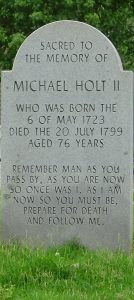
Holt’s replacement tombstone, prominent on the mound and facing toward you, bears an intriguing epitaph copied from the original. Holt was a captain of the local militia in 1768, during protests by the Regulators against the colony’s government over corruption and unfair tax practices. As a court justice, he was a target. He was one of several men whipped by the Regulators during their takeover of the Hillsborough courthouse that year.[5] Royal Gov. William Tryon marched with militia units from Charlotte and Salisbury to restore order. He probably stayed in Holt’s home. The Regulators did not confront him, however, and Tryon eventually left.
Holt’s plantation was huge, extending along this side of today’s I-40/85 from east of his graveyard all the way west to the other side of modern Burlington. As no action was taken by the royal government to address the Regulators’ complaints, their violence increased, and Tryon finally marched another army to confront them in 1771. Fittingly, the Battle of Alamance that ended the War of Regulation was fought on Holt’s land near today’s town of Alamance. Holt may have taken part alongside Tryon.
In 1776, Holt took the side of the king and formed a Loyalist militia unit. In February he led them from here toward Cross Creek (now Fayetteville). Tories were gathering there to support a planned British invasion from the mouth of the Cape Fear River. Holt apparently did not know that was their intent. He learned it on the way and changed his mind, returning here with some of his men and planning to become a Patriot. He thus avoided disaster at the Battle of Moore’s Creek Bridge. But he was arrested as a Tory anyway, and imprisoned in Halifax and Philadelphia. (This may be why Lee thought Tarleton would be camped here.) Holt eventually convinced the state government of his change of heart, was released on parole, and spent the rest of the war peacefully running his plantation and tavern.[6]
Sometime prior to 1783, a former Loyalist militia soldier traveled from Salem along the Hillsborough-Salisbury Road to Holt’s home. They had met in prison during the war. He described Holt as uneducated and unpolished, but with “a large share of good sense and sound judgment.”[7]
Battle Map
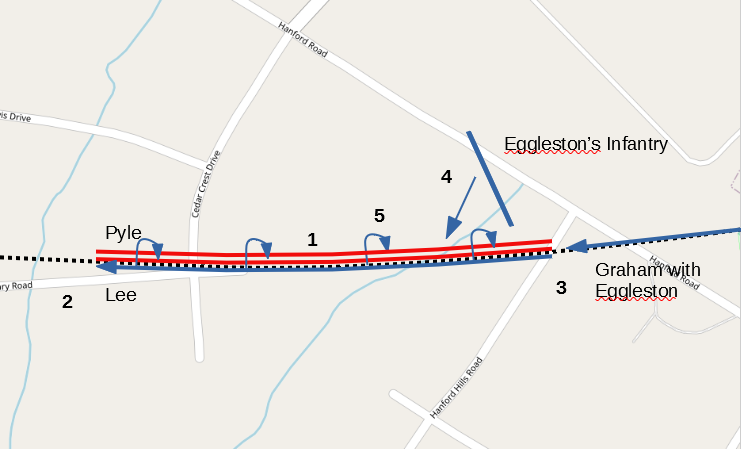
Pyle’s Defeat: Troop locations are approximate. 1) Tory militia on horseback turn around and wait. 2) Patriot cavalry (as British) ride alongside; Lee (as Tarleton) stops to greet Pyle at front. 3) Patriot officers in rear realize Tories aren’t captured; Eggleston strikes one. 4) Patriots on flank open fire. 5) Patriot cavalry turns and attacks.
Casualties
 Tory: At least 93 killed, 200 wounded.
Tory: At least 93 killed, 200 wounded.- Continental/Patriot: 1 wounded; it is possible several Patriot prisoners held by Pyle were also killed by mistake.
After the Battle
Among the Patriot militia were a few Catawbas, whose unit arrived last at the scene, too late for battle. Per their custom the warriors began to spear the wounded, killing seven or eight until the Patriot officers stopped them.[8]
A prisoner being quizzed about the area, likely a relative of Michael Holt, still thought he was talking to Tarleton. According to Lee in his memoirs, writing in third person, the man said: “’Well, God bless your soul, Mr. Tarleton, you have this day killed a parcel of as good subjects as ever his Majesty had.’ Lee, who at this time was not in the humor for quizzing, interrupted him, saying: ‘You d—d rascal, if you call me Tarleton, I will take off your head. I will undeceive you: we are the Americans and not the British. I am Lee of the American Legion, and not Tarleton.’”[9]
The killing was not over. Patriot Moses Hill reported, “I was (invited) by some of my comrades to go and see some of the prisoners. We went to where six were standing together. Some discussion taking place, I heard some of our men cry out ‘remember Bluford’ (Buford[10]) and the prisoners were immediately hewed to pieces with broad swords. At first I bore the scene without any emotion, but, upon a moments reflection I felt such horror as I never did before nor have since, and returning to my quarters and throwing myself upon my blanket I contemplated the cruelties of war…”[11]
Some of the Tories reached Tarleton after dark and warned him. He wanted to find Lee and attack, but was ordered back to Hillsborough by Cornwallis.
A couple hours later Lee’s force arrived at Tarleton’s abandoned camp. A wounded man lying by the side of the road turned out to be a boy of sixteen. He told them he had “come up to view the British through curiosity,” but “for fear he might give information to our camps they had run him through with a bayonet & left him for dead.” Hall said this “released me of my distress and feelings for the slaughter of the Tories…”[12]
A family history says Pyle, around 58, lost an eye and some or all fingers of his left hand in the fight.[13] In 1849, a “Dr. Holt” took a visiting artist to a pond about a half-mile northwest of the battle site. He claimed Pyle hid there afterward, submerged to his nose at times to avoid the searching militia, before slipping out after dark to escape home.[14] It seems unlikely a badly wounded Pyle could have stayed in a pond for hours in February without freezing or bleeding to death.
This devastating defeat, called “Pyle’s Massacre” by some, received wide press attention. It also ended any chance of more Loyalists joining Cornwallis. In turn, that contributed to the difficulties, and extra casualties, the British suffered at the Battle of Guilford Court House three weeks later.
Historical Tidbit
After the Continental Army was badly defeated at the Battle of Camden (S.C.) in July 1780, the remains of the army regrouped in Hillsborough. In mid-November, around a thousand soldiers and an unknown number of militia marched west toward Charlotte across the killing field of this road.
More Information
- ‘Battle of Haw River’, American Revolutionary War, 2017 <https://revolutionarywar.us/year-1781/battle-haw-river/> [accessed 2 December 2019]
- ‘Battle of Pyle’s Defeat Facts & Summary’, American Battlefield Trust, 1917 <https://www.battlefields.org/learn/revolutionary-war/battles/pyles-defeat> [accessed 2 December 2019]
- Bright, Jeffrey G., and Stewart E. Dunaway, Pyle’s Defeat—The Most Comprehensive Guide: Case Closed, 2011 <https://Lulu.com/Sedunaway>
- Bright, Jeffrey G., and Stewart E. Dunaway, The American Revolution in North Carolina: An Exhaustive Reference of the Piedmont, 2013 <https://Lulu.com/Sedunaway>
- Caruthers, E. W., Interesting Revolutionary Incidents and Sketches of Character, Chiefly in the ‘Old North State.’ (Philadelphia : Hayes & Zell, 1856) <http://archive.org/details/interestingrevol00incaru> [accessed 23 April 2020]
-
DeMond, Robert, The Loyalists in North Carolina During the Revolution (Duke University Press, 1940)
- Graham, William A. (William Alexander), General Joseph Graham and His Papers on North Carolina Revolutionary History (Raleigh, N.C.: Edwards & Broughton, 1904) <http://archive.org/details/cu31924032738233> [accessed 27 March 2020]
- Graves, Will, ‘Pension Application of Moses Hall, W10105’, 1835 <https://revwarapps.org/w10105.pdf> [accessed 13 November 2024]
- Jordan, Howard, ‘The Pyle Family’, 1977, Local History Collection, Chatham County Public Library
- Lewis, J. D., ‘The Battle of Haw River’, The American Revolution in North Carolina, 2011 <https://www.carolana.com/NC/Revolution/revolution_battle_of_haw_river.html> [accessed 27 May 2020]
- Lossing, Benson John, The Pictorial Field-Book of the Revolution: Or, Illustrations by Pen and Pencil of the History, Biography, Scenery, Relics and Traditions, of the War for Independence (New York : Harper & Bros., 1851) <http://archive.org/details/pictorialfieldbo02lossuoft> [accessed 25 November 2020]
- MacNiven, Robert Donald, ‘Slaughter Was Commenced: A Study of American Revolutionary War Massacres’ (unpublished Dissertation, The University of Edinburgh, 2020)
- ‘Marker: G-22’, North Carolina Highway Historical Marker Program <http://www.ncmarkers.com/Markers.aspx?MarkerId=G-22> [accessed 2 December 2019]
- McGowan, Molly, ‘History, Revised: State Corrects Alamance County Revolutionary War Marker’, The Times-News, 2013 <https://www.thetimesnews.com/article/20130428/News/304289924> [accessed 22 May 2020]
- ‘Michael Holt, II (1723-1799)’, Find a Grave Memorial <https://www.findagrave.com/memorial/130453095/michael-holt> [accessed 22 May 2020]
- North Carolina Council of Safety, ‘Minutes of the North Carolina Council of Safety, June 05, 1776 – July 16, 1776, Volume 10, Pages 618d-647’, Documenting the American South: Colonial and State Records of North Carolina, 1776 <https://docsouth.unc.edu/csr/index.php/document/csr10-0272> [accessed 5 October 2021]
- O’Kelley, Patrick, Nothing but Blood and Slaughter The Revolutionary War in the Carolinas, Volume Three, 1781 (Booklocker.com, Inc., 2005)
- ‘On This Day in History – February 24, 1781’, Revolutionary War and Beyond <https://www.revolutionary-war-and-beyond.com/pyles-massacre-in-north-carolina.html> [accessed 2 December 2019]
- Pancake, John S., This Destructive War: The British Campaign in the Carolinas, 1780-1782 (University, AL : University of Alabama Press, 1985) <http://archive.org/details/thisdestructivew00panc> [accessed 13 October 2020]
- Piecuch, Jim, ‘“Light Horse Harry” Lee and Pyle’s Massacre’, Journal of the American Revolution, 2013 <https://allthingsliberty.com/2013/06/light-horse-harry-lee-and-pyles-massacre/> [accessed 2 December 2019]
- Rankin, Hugh F., The North Carolina Continentals (Chapel Hill: The University of North Carolina Press, 1971)
- Stokes, Durward, ‘Holt, Michael, Jr.’, NCpedia, 1988 <https://www.ncpedia.org/biography/holt-michael-jr> [accessed 22 May 2020]
- ‘The Battle of Haw River’ <https://www.myrevolutionarywar.com/battles/810225-haw-river/> [accessed 2 December 2019]
- ‘Tories Faced Several Choices in Last Days’, The Sanford Herald (Sanford, N.C., May 1976), Bicentennial Edition edition
- Troxler, Carole, Pyle’s Defeat: Deception at the Racepath (Graham, NC: Alamance County Historical Association, 2003)
- Troxler, George, ‘Pyle, John’, NCpedia, 1994 <https://www.ncpedia.org/biography/pyle-john> [accessed 4 May 2020]
- Troxler, George, Pyle’s Massacre, February 23, 1781 (Burlington, N.C.: Alamance County Historical Association, 1973)
[1] Bright and Dunaway 2011.
[2] McGowan 2013.
[3] Graham 1904.
[4] Two different answers appear within Graham 1904, the other being: “A friend of his Majesty.” The one used here is quoted directly from a letter by then-Capt. Graham.
[5] Demond 1940, Stokes 1988.
[6] Stokes.
[7] Hatch, Charles, The Battle of Moore’s Creek Bridge (Office of History and Historic Architecture, U.S. National Park Service, 1969).
[8] Graham.
[9] Quoted in Graham.
[10] A reference to Col. Abraham Buford, some of whose soldiers were killed after surrendering to Tarleton’s cavalry at the Battle of the Waxhaws (S.C.).
[11] Graves 1835.
[12] Ibid.
[13] Jordan 1977.
[14] Lossing 1851. This is the earliest source found for the story of “Pyle’s pond,” often repeated in later works. Caruthers (1856) tells it using the same or similar words without citing his source, so he likely was quoting Lossing’s book.
← Hillsborough | Regulators Tour | Clapp’s Mill →
